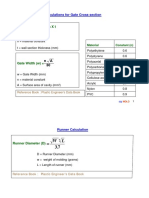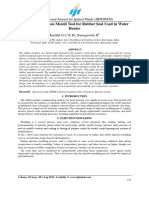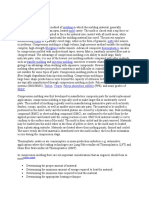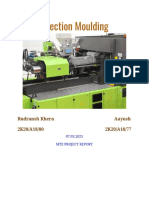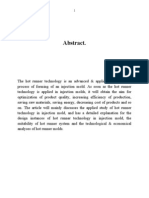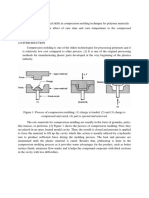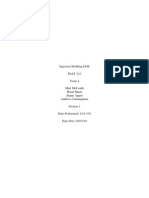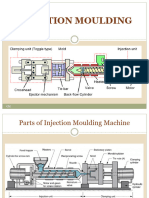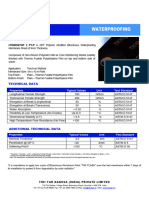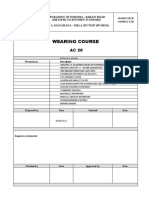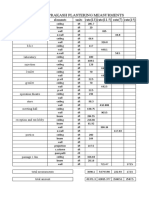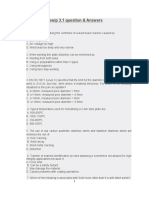Compression Moulding Process - An Overview Ijariie11168
Compression Moulding Process - An Overview Ijariie11168
Uploaded by
ARUN KUMAR KoterimadathilCopyright:
Available Formats
Compression Moulding Process - An Overview Ijariie11168
Compression Moulding Process - An Overview Ijariie11168
Uploaded by
ARUN KUMAR KoterimadathilOriginal Description:
Original Title
Copyright
Available Formats
Share this document
Did you find this document useful?
Is this content inappropriate?
Copyright:
Available Formats
Compression Moulding Process - An Overview Ijariie11168
Compression Moulding Process - An Overview Ijariie11168
Uploaded by
ARUN KUMAR KoterimadathilCopyright:
Available Formats
Vol-5 Issue-6 2019 IJARIIE-ISSN(O)-2395-4396
Compression Moulding Process – An Overview
Mayuresh Nitin Madiwale
BE Student, Department of Mechanical Engineering, LGNSCOE, Nashik, Maharashtra, India
ABSTRACT
Known as one of the oldest plastic processing methods, compression moulding (CM) is widely used in plastic
processing plants due to its advantages which are lesser seen in other methods. Though injection moulding is the
most widely used process, it lacks in some properties which can be achieved in compression moulding. This process
is used to give a desired shape to the plastic with the use of high temperature and pressure. It can be used for
thermoplastics as well as for thermosetting. In plastics, Thermosets and composite plastics have low melt flow index
and the fact that they require high pressure to cure, compression moulding is most common process selected. The
finished product from compression moulding is seen to be tough and hard to sustain various loads applied and the
surface can be made smooth as per requirement. The scrap produced (flash) is lesser than injection moulding
(runners and gates produced during the process). The process setup includes the plastic preform (either powder or
tablets) is usually preheated is placed in the heated mould cavity. Heating of mould is done to catalyze the curing
reaction. Pressure is then applied with help of a power press for a certain period of time known as curing time. The
part thus takes the shape of mould cavity and is then ejected from the mould with ejector system. For an optimum
utilization of this process, various parameters are to be controlled such as part geometry, part material, mould
quality, mould temperature, curing time, clamping pressure, breathe cycle, preheating and charge quantity. This
paper covers a brief overview of the compression moulding process followed by the controlling process parameters.
Keyword: - Compression Moulding, Thermoplastics, Thermosets, process parameters, curing, breathe cycle
1. INRODUCTION-
Compression molding is among the oldest materials processing techniques. In commercial use, compression
moulding is the most simple and reliable process. Due to its simplicity and availability, it is most widely used
process. Product areas are lighting and electrical devices, closures, transportation, and appliances. Specific items are
electrical wall switch plates and receptacles, circuit breakers, bottle caps, buttons, packaging, containers, covers,
protective helmets, pump components, gears, brake parts, frames, pulleys, vehicle panels, dishware, and appliance
housings, bases, handles, and knobs. [1].
1.1 Nomenclature of Compression Moulding Process
Compression moulding process require following components:-
1. Component raw material
The material needed to be molded in cavity is required with preprocessing done. Pre-procedures like
preheating, addition of any binding agents or reinforcement. Raw material may come in form of powders,
resins, sheets or granules. These materials are then needed to be processed before placing them in cavity.
Some plastic materials are mixed with binding agents and reinforcements like fibre, or with some other
plastics to make a composite. Powders are needed to be tablated in a tablating machine, as this improves
the performance and helps to preserve the powder for a long period of time.
11168 www.ijariie.com 1615
Vol-5 Issue-6 2019 IJARIIE-ISSN(O)-2395-4396
Fig 1 Moulding powder. Fig 2 Preform
2. Mould with desired shaped cavity
A precise and accurate mould is the key element for this process. The mould should be able to withstand
tremendous pressure. It should posses following properties:-
Accuracy and precision – the punch and cavity inserts should meet high accuracy and precision.
Strength – the mould should sustain the working pressure and it would be better if it work hardens.
Reliability – it should be reliable for mass productions.
Alignment – the alignment between the punch – cavity, support pillars – bushings, ejector pins
holes should be proper.
Surface finish – the surface of the punch and cavity should be super finished to achieve the part
surface smooth.
Coating/plating – the punch and cavity surface should be coated or plated with a harder material to
reduce wear and tear,
Hardening – the plates of mould should be hardened to be immune to scratches and wear occurred
while regular operation.
Cost – it should be available at lower costs.
Fig 3 General construction of mould
11168 www.ijariie.com 1616
Vol-5 Issue-6 2019 IJARIIE-ISSN(O)-2395-4396
3. Moulding machine
The machine is the fundamental element of this process. A compression moulding machine is similar to a
power press except power press have a fast operation and do not stay for more time at stroke. CM machines
stay for a predetermined time when actuated. It is more similar to a UTM machine.
Fig 4 Compression moulding machine
1.2 Process Flow
The process takes place in following steps,
Step-1. Heating the mould
The mould is heated to a certain temperature as per the plastic raw material requirement. Usually the raw material
manufacturer suggests the mould temperature. e.g.- for single stage and two stage phenolic moulding compounds,
PLENCO suggests the Mold Temperatures should be 165° - 182°C (330° - 360°F).[2]
Step-2. Preheating the plastic
The material can be Sheet Moulding Compound (SMC), Bulk Moulding Compound (BMC), Thick Moulding
Compound (TMC) or the material can either be granulated powder or a preform tablet. Preheating is done in a small
convection heater. The raw material is preheated to a certain temperature for two main reasons:-
To remove moisture content as thermoset powder has tendency to absorb moisture from air.
To reduce the curing time required by material in the mould cavity
Step-3. Placing the plastic in the cavity and mould closing
The preheated plastic is then placed into the mould cavity followed by closing the mould halves together. After
closing the mould, breathe cycle is introduced to remove any air bubbles trapped inside. The pressure and
temperature is then held for some period of time
11168 www.ijariie.com 1617
Vol-5 Issue-6 2019 IJARIIE-ISSN(O)-2395-4396
Step-4. Curing reaction
Curing is a chemical process employed in polymer chemistry and process engineering that produces the toughening
or hardening of a polymer material by cross-linking of polymer chains. Even if it is strongly associated with the
production of thermosetting polymers, the term curing can be used for all the processes where starting from a liquid
solution, a solid product is obtained. [3]
Step-5. Mould opening and Ejection
After the plastic is cured, the part can be removed from the mould. To remove the part, ejection system is employed.
The mould has ejector pins and ejector plates assembled on both halves below the cavity and punch back plates. The
plates push the ejector pins which remove the part from cavity.
Step-6. Cleaning of mould
After the ejection, cycle is completed. For next cycle, mould has to be cleaned to remove any dirt, dust, flash from
the cavity and punch surface. The cleaning can be done by wiping off with a cloth or by blowing pressurized air on
the surface.
Fig 5 Stepwise procedure of CM process
1.3 Process Parameters
Following parameters should b controlled in compression moulding process:-
I. Part Geometry
The part to be molded should have a specific shape and size. Bigger the part, bigger the mould has to be
made and higher the pressure requirement. The design should be correct and satisfying the need of
application. Poor design leads to poor performance. CM cannot handle very intricate designs, thus part
should be designed accordingly.
II. Shot Size
The amount of raw material required for a part is known as shot size. It is determined from the weight of
part required. Shot size is oftenly taken a bit more than the requirement to ensure complete filling of cavity.
Flashes (scrap) are expected in final part as it indicates complete filling of cavity. It is oftenly considered
by trial and error basis. Low shot size leads to incomplete filling of cavity.
III. Part Material
While selecting the process, part material is the main factor. Viscosity of plastic is deciding factor. Very
viscous plastics are harder to compress and require high pressure and temperature. Melt Flow Index is the
factor considered in plastics, it is the test done on plastics to determine the viscosity when plastic is melted.
The test consists of melting of the plastic in a small cylinder covered with heater element. Then the piston
11168 www.ijariie.com 1618
Vol-5 Issue-6 2019 IJARIIE-ISSN(O)-2395-4396
pushes the plastic after melting as a predetermined weight is placed above it. after some time weight of
displaced plastic is taken and MFI is calculated. Depending on the Melt Flow Index, the plastics can be
classified as:-
1. Low melt flow index
These plastics have low viscosity and hence have less fluidity. These require severe pressure to
flow and cover each and every corner of the mould cavity. For these plastics use of compression
moulding is must as it is best suitable process
2. Medium melt flow index
These types of plastics have medium fluidity. They may or may not be processed by compression
moulding method. These have a medium viscosity and do not require high pressures and
temperatures.
3. High melt flow index
These have a great fluidity and lowest viscosity amongst above. Injection moulding is best suitable
for these plastics and requires lowest time to cover mould cavity. Cycle time is usually lower of
these plastics.
Apart from Melt Flow Index, the type of plastic is also necessary. Whether the plastic is a thermoplastic,
thermoset or a composite of plastic and some kind of additive and reinforcement (fibre matrix) is also a
question discussed while selecting the process.
IV. Mould Quality
In order to achieve a smooth finish on the part, the cavity surface should be super finished and coated with
a hard material to reduce its wear and tear. The mould should pass the overall quality parameters like
alignment, strength, stress concentration, fits, limits, tolerances and allowances should be considered with
high accuracy. The mould should be made of optimum quality material according to international standards
like HASCO, DME, DMS, DESOUTTER, UDDFORM, etc. coating/plating should be done to reduce wear
and tear.
V. Mould Material
CM process involves use of high pressure presses. To sustain this pressure, heavy duty metals are used.
There are many metals from which moulds can be made. Preferably materials like P 20 steel, S 7 steel, AI
QC7 and AI7075 are used. [4]
Fig 6 Metals used in moulds and their properties.
11168 www.ijariie.com 1619
Vol-5 Issue-6 2019 IJARIIE-ISSN(O)-2395-4396
VI. Temperature Control
1) Mould Heating
In compression moulding, mostly used plastics are thermosets. These require heating provision to cure
unlike thermoplastics which require cooling for solidification. To heat the mould, various types of heaters
can be used. Following are some types of heating systems which can be employed [5]:-
1. Heating and cooling channels (flowing oil or water)
2. Jet impingement (heating by flame)
3. Infrared heaters
4. Inductive heating
5. Resistance heating
6. Cartridge heaters
7. Surface heaters
8. Ceramic heaters
9. Carbon fibre heating layer
2) Preheating
The thermosets are required to be preheated before placing into the mould. This helps in many ways.
Preheating is done to achieve following advantages [6]:-
1. Reduced the cycle time.
2. More fluidity to get inside difficult corners than with cold preform
3. Reduced moisture content absorbed by material. Moisture is unwanted in plastic
VII. Clamping Pressure
Clamping pressure is the pressure exerted by the press in order to squeeze the plastic to cover the mould
cavity. The machine needs to force the plastic to each and every corner of cavity to acquire the desired
shape and size. The pressure should be specifically calculated such that it should not be too high or too low.
Too high pressure will start to damage the mould and results in severe wear and tear. Too low pressure on
the other hand, will result in improper filling of cavity and inaccurate thickness and depth of the part. As
per PLENCO, the formula of clamping pressure is as follows [7],
Clamping pressure required = area of part at parting line * effective pressure required by material
e.g.:- for circular part,
Clamp pressure required (in tonnes) = R² * π * T/in²
Where,
R = radius of the part at parting line (inches)
T/in²:- Effective tonnage required by material
Sample problem: -
Find the tonnage required for a part measuring 76mm in diameter made of Bakelite with effective pressure
of 3 T/in². The mould has 4 nos of cavities. Assume Factor of Safety of 10%.
Given: - D = 76mm, ∴ R = 36mm ≈ 1.4960 in
∴ 84.3712 tonnes + 10%
T/in² = 3
∴ 84.3712 + 8.43712
n=4
FOS = 10% = 92.8090 tonnes
Solution: - 1.4960² * π * 3 * 4
∴21.0928 * 4
11168 www.ijariie.com 1620
Vol-5 Issue-6 2019 IJARIIE-ISSN(O)-2395-4396
Therefore, the pressure requirement of machine to mould the parts is 92.8090 tonnes. As standard
machines are available in market, a 100 ton machine would be suitable for moulding.
VIII. Curing Time
Curing time is the time taken by plastic to completely solidify and harden. The word curing is used for
thermosets only as these plastics go through an irreversible chemical reaction. While for the thermoplastics,
process is reversible as they solidify when cooled and melt when heat is provided. Thermoset curing can
vary according to size and materials. According to size, curing can take anywhere from few seconds for
small sizes to an hour for large sizes. According to thermoset materials, curing time varies based on the
chemical composition.
IX. Breathe Cycle
When the pressure s fully applied and the mould closes completely, there are chances of blow holes
creating inside the cavity. This can ruin the surface of part also the cavity may or may not be filled
completely. To eliminate this, breathe cycle is introduced. Breathe cycle is nothing but just a degassing
phase added to cycle time before completely applying the pressure. This removes any vapour, air, gas
trapped inside the cavity. The breathe cycle is almost always used with phenolics and other formaldehyde
molding compounds, and mostly in compression molding [8].
Fig 7 Breathe cycle
X. Shrinkage
After ejection of part from mould, it has a tendency to shrink. Due to this, the final part may differ than
intended dimensions. To eliminate this, a shrinkage allowance is considered in manufacturing of the mould.
Dimensions of cavity are taken more than the actual design.
e.g.:- shrinkage of two stage phenolic compression moulding compound “04349” is 0.0026 m/m [9]
2. ADVANTAGES
Compression moulding comes with some good advantages. Some advantages are enlisted below:-
1. Low running cost.
2. Good dimensional stability.
3. Density of part is uniform.
4. Shrinkage of part is uniform throughout.
5. No degradation of fibers during flow of plastic.
11168 www.ijariie.com 1621
Vol-5 Issue-6 2019 IJARIIE-ISSN(O)-2395-4396
6. Great impact strength of part.
7. Uniform flow of plastic in entire cavity.
8. Warping and internal stresses are minimal.
9. Shorter lead time.
3. DISADVANTAGES
Compression moulding has some disadvantages too. Some of them are as enlisted below:-
1. Initial cost is high.
2. Uneven parting lines are available.
3. Flash (scrap) produced cannot be recycled.
4. High cycle time as curing time is more.
5. Not suitable for complex parts as material may not flow in intricate gaps.
4. APPLICATIONS
Compression moulding is still used widely in following applications
1. Dinnerware like plates, bowls are made of melamine by compression moulding process.
2. Handles of utensils like cookers, pans are made using CM process.
3. In earlier times, door knobs were made with this process.
4. Television, telephone housings.
5. Radio housings.
6. Electrical parts like switches, switch boards, insulators.
7. Body and interior panels of cars, vans, etc.
5. PROBLEMS OCCURING IN COMPRESSION MOULDING PROCESS
While performing the process, there can be some issues regarding the part. Following problems can occur if the
processing parameters are not followed correctly as per PLENCO. [10]
1. Bulge on opposite side of insert.
2. Cure blister
3. Dull appearance
4. Excessive flash
5. Flow lines
6. Procure or hard spots
7. Mould stains
8. Mottled surface appearance
9. Short shot
10. Orange peel
11. Shrinkage
12. Sink marks
13. Skin blisters
14. Sticking in mould
15. Burn mark
16. Warpage
6. CONCLUSIONS
The compression moulding process is one of the non-conventional processes in plastic engineering sector. The
process is most suitable for low melt flow thermosets. The parts can possess great surface finish and strength with
less warpage. The fiber degradation during flow is minimal with great dimensional stability. The density and
shrinkage throughout is uniform. The process can perform best if following parameters are controlled.
11168 www.ijariie.com 1622
Vol-5 Issue-6 2019 IJARIIE-ISSN(O)-2395-4396
1. Part geometry – a good design leads to a good product.
2. Shot size – to properly fill the cavity, proper shot size is necessary. To be taken a bit more than part weight.
3. Part material – proper selection of process depends on part material.
4. Mould quality – ensure optimum quality mould is used to get optimum quality part.
5. Mould material – strong mould lasts longer and gives appropriate part quality.
6. Temperature control – mould heating and plastic preheating should be done properly.
7. Clamping pressure – pressure to mould should be calculated properly to avoid improper part thickness.
8. Curing time – mould holding time depends on curing time. Complete solidification requires proper time.
9. Breathe cycle – to avoid blow holes and air gaps, breathe cycle should be employed.
10. Shrinkage – plastic shrinks after cooling, proper allowances should be considered in mould manufacturing.
7. REFERENCES
[1]. Robert A. Tatara, 14 - Compression Molding, Editor(s): Myer Kutz, In Plastics Design Library, Applied Plastics
Engineering Handbook (Second Edition), William Andrew Publishing, 2017, Pages 291-320, ISBN 9780323390408
[2]. Plastic Engineering Company, “Compression Molding Guidelines for Preheat Molding of PLENCO Single
Stage & Two Stage Phenolic Molding Compounds”. https://www.plenco.com/tips/compsstips.html
[3]. Pham, Ha Q.; Marks, Maurice J. (2012). "Epoxy Resins", Ullmann's Encyclopedia of Industrial Chemistry
Weinheim: Wiley-VCH. Doi:10.1002/14356007.a09_547.pub2.
[4] Vinoth Kumar Dhananjayan, “Design and Analysis of a Compression Molded Carbon Composite Wheel
Center”, the University Of Texas at Arlington May 2013
[5]. T Oppelt, J Schulze, H Stein, and B Platzer, “Comparison of methods for mould surface heating – Part 1:
Review”, Smithers Rapra Technology, Gummi Fasern Kunststoffe, No. 8, 2012, pp. 518–523
[6] Plastic Engineering Company, “Preforming & Preheating”,
https://www.plenco.com/plenco_processing_guide/Sect%2014%20Preforming%20&%20Preheating
[7] Plastic Engineering Company “Cold Powder Compression Molding Startup Procedure for Phenolic & Melamine-
Phenolic Molding Compounds”.
https://www.plenco.com/plenco_processing_guide/Sect%2015%20Cold%20Powder%20Compression%20Setup
[8] Dominick V. Rosato, Donald V. Rosato, “Injection Molding Handbook”, CBS Publishers & Distributors, ISBN
8123913648, 9788123913643, year – 2000
[9] Plastic Engineering Company,” Materials Engineering Laboratory Data Report for Plenco 04349 Compression
Molding Compound”, https://www.plenco.com/data/04349c
[10] Plastic Engineering Company, “Philosophy of Troubleshooting Compression Molding Problems”,
https://www.plenco.com/plenco_processing_guide/Sect%2018%20Compression%20Troubleshooting%20Guide
Image sources:-
[1] Fig 4
https://www.prm-
taiwan.com/F0010/S0122/product_i_SINGLE_BODY_OIL_HYDRAULIC_COMPRESSION_MOLDING_MACH
INE_FC_SERIES.html
[2] Fig 6 Dominick V. Rosato, Donald V. Rosato, Matthew V. Rosato, “Plastic Product Material and Process
Selection Handbook”, Publisher: Elsevier Science & Technology Books, ISBN: 185617431X, Pub. Date: September
2004, page no 514.
11168 www.ijariie.com 1623
Vol-5 Issue-6 2019 IJARIIE-ISSN(O)-2395-4396
[3] Fig 7 Charles A. Harper, “Handbook Of Plastic Processes”, Published by John Wiley & Sons, Inc., Hoboken,
New Jersey, ISBN-13: 978-0-471-66255-6 (cloth) ISBN-10: 0-471-66255-0, page no 459
BIOGRAPHY
Mayuresh Nitin Madiwale
BE student, Department of Mechanical Engineering,
Lt. G. N. Sapkal College of Engineering,
Savitribai Phule Pune University (SPPU),
11168 www.ijariie.com 1624
You might also like
- Project Report: Plastic Injection MouldingDocument26 pagesProject Report: Plastic Injection MouldingShubham Kumar JhaNo ratings yet
- Mold Design CalculationsDocument23 pagesMold Design CalculationsARUN KUMAR Koterimadathil100% (3)
- Glass As A Building MaterialDocument45 pagesGlass As A Building MaterialADITYA GUPTANo ratings yet
- Injection Moulding Process An Overview Ijariie15225Document15 pagesInjection Moulding Process An Overview Ijariie15225tou kaiNo ratings yet
- Design of Injection Mould Tool For Rubber Seal Used in Water HeaterDocument7 pagesDesign of Injection Mould Tool For Rubber Seal Used in Water HeaterAgonafirNo ratings yet
- Compression MoldingDocument17 pagesCompression MoldingSoloproNo ratings yet
- Compression MouldingDocument41 pagesCompression MouldingSuranjana Mandal100% (1)
- 1.polymer ProcessingDocument23 pages1.polymer Processingafia rahmanNo ratings yet
- Compression Molding Is A Method ofDocument4 pagesCompression Molding Is A Method ofsathishpantaloonNo ratings yet
- Advances in Injection MoldingDocument15 pagesAdvances in Injection MoldingPranav PatilNo ratings yet
- Manufacturing of Polymer CompositesDocument17 pagesManufacturing of Polymer CompositesMaya VargheseNo ratings yet
- Final Part.2Document27 pagesFinal Part.2BindhuNo ratings yet
- Plastics and CompositesDocument23 pagesPlastics and CompositesAamir RashidNo ratings yet
- Investigate of Parameter Setting in Plastic Injection MoldingDocument28 pagesInvestigate of Parameter Setting in Plastic Injection MoldingKristine de ClaroNo ratings yet
- Unit-Iii MANUFACTURING METHODS: Autoclave, Tape Production, Moulding Methods, FilamentDocument13 pagesUnit-Iii MANUFACTURING METHODS: Autoclave, Tape Production, Moulding Methods, FilamentSaisurendra VeerlaNo ratings yet
- Injection and Blow Moulding PlasticDocument23 pagesInjection and Blow Moulding PlasticAbhi She KNo ratings yet
- Different Types of Blow MoldingDocument11 pagesDifferent Types of Blow MoldingParvateshNo ratings yet
- Injection Moulding Lab ReportDocument27 pagesInjection Moulding Lab ReportErnie Yana IINo ratings yet
- Prepared By-Chaudhari M.M SVCP (Sinhgad), PUNE (INDIA) Dept. of Mech. EnggDocument39 pagesPrepared By-Chaudhari M.M SVCP (Sinhgad), PUNE (INDIA) Dept. of Mech. EnggMitul patelNo ratings yet
- Sect 4 Injection MoldingDocument3 pagesSect 4 Injection MoldingPassmore DubeNo ratings yet
- TrosDocument14 pagesTrosyeabsira getachewNo ratings yet
- Design & Development of Vaccum Forming Machine & DIE'Document5 pagesDesign & Development of Vaccum Forming Machine & DIE'ALAZAR MICHAELNo ratings yet
- Introduction To Plastics Processing CIPET.Document55 pagesIntroduction To Plastics Processing CIPET.Pranav DNo ratings yet
- MTE Innovative Project Report Rudransh Khera 2K20 - A18 - 80Document8 pagesMTE Innovative Project Report Rudransh Khera 2K20 - A18 - 80Ayush SinghNo ratings yet
- 1Document4 pages1nduy20295No ratings yet
- Packaging AssignmentDocument11 pagesPackaging AssignmentAbhijeetKumar100% (1)
- Gear Type Injection MouldingDocument47 pagesGear Type Injection MouldingJohn Ajish50% (2)
- Basics of Mold DesignDocument15 pagesBasics of Mold DesignPedro Agirre IturbeNo ratings yet
- Mt1 Unit 5 NotesDocument11 pagesMt1 Unit 5 NotesvelavansuNo ratings yet
- (212051542) Lab 5 - Injection Moulding LaboratoryDocument9 pages(212051542) Lab 5 - Injection Moulding LaboratoryNur Anisa Wasilah Binti Mohd Noor ShahrinNo ratings yet
- Vatan Training ReportDocument35 pagesVatan Training Reportvikasjangra631No ratings yet
- Compression Injection MouldingDocument4 pagesCompression Injection MouldingTanushka SarangNo ratings yet
- Plastic Injection Training ReportDocument31 pagesPlastic Injection Training ReportsazmsNo ratings yet
- Thermoforming Design Guidelines: 3808 North Sullivan Road, Building 6 Spokane, Washington, 99216Document42 pagesThermoforming Design Guidelines: 3808 North Sullivan Road, Building 6 Spokane, Washington, 99216JeffNo ratings yet
- Project Final Year On The Injection Plastic ModuleDocument41 pagesProject Final Year On The Injection Plastic ModuleSajid Zeya100% (1)
- Final Report Plastic Injection MoldingDocument38 pagesFinal Report Plastic Injection MoldingshriNo ratings yet
- Plastic Manufacturing ProcessesDocument6 pagesPlastic Manufacturing ProcessesHimanshu TiwariNo ratings yet
- Assignment 3Document4 pagesAssignment 3Devashish KolteNo ratings yet
- Ch13 1 PolymerMelt&ExtrusionDocument32 pagesCh13 1 PolymerMelt&ExtrusionPrabhu MechNo ratings yet
- Processes Encountered in Plastic IndustriesDocument16 pagesProcesses Encountered in Plastic IndustriesdebdeepNo ratings yet
- Presentation of Industrial Training In: Li-Tech Electro PlastDocument20 pagesPresentation of Industrial Training In: Li-Tech Electro PlastOM B (RA2011018010046)No ratings yet
- Fabrication of Gear Type Injection Moulding AchineDocument29 pagesFabrication of Gear Type Injection Moulding AchineAnonymous ITnkbIEF75% (4)
- Injection MoldingDocument5 pagesInjection MoldingRodrigo AndradeNo ratings yet
- Blow Mould Tool Design and Manufacturing Process For 1litre Pet BottleDocument10 pagesBlow Mould Tool Design and Manufacturing Process For 1litre Pet BottleSushobhan DasNo ratings yet
- Design and Manufacture of C-Clamp by Injection Molding ProcessDocument6 pagesDesign and Manufacture of C-Clamp by Injection Molding ProcessEng Stephen ArendeNo ratings yet
- Designing With Advance Material: Lab Report - Important Industrial Methods of FRP Composite FabricationDocument9 pagesDesigning With Advance Material: Lab Report - Important Industrial Methods of FRP Composite Fabricationprashant chouhanNo ratings yet
- Rubber MoldingDocument5 pagesRubber MoldingSubramanya Seeta Ram PrasadNo ratings yet
- Processing of Polymers and Composites: Lecture 23 - 09/03/2020Document9 pagesProcessing of Polymers and Composites: Lecture 23 - 09/03/2020MK SaravananNo ratings yet
- Chapter - 3 Composite Manufacturing: Manufacturing Is A Very Broad Discipline and Encompasses Several Processes Such AsDocument32 pagesChapter - 3 Composite Manufacturing: Manufacturing Is A Very Broad Discipline and Encompasses Several Processes Such AsshreedharkoilekarNo ratings yet
- Seminar ReportDocument23 pagesSeminar Reportbijithbigb0% (1)
- Experiment 1 - Compression MoldingDocument16 pagesExperiment 1 - Compression MoldingJasmine NguNo ratings yet
- Hand Lay UpDocument29 pagesHand Lay UpRavendran Krishnan100% (2)
- Investigate of Parameter Setting in Plastic Injection MoldingDocument28 pagesInvestigate of Parameter Setting in Plastic Injection MoldingAnurag Srivastava100% (1)
- M. Ahsan Ali (Assignment)Document8 pagesM. Ahsan Ali (Assignment)Malik ahxanNo ratings yet
- Types of Composite ManufacturingDocument42 pagesTypes of Composite Manufacturingu2b11517100% (2)
- Global Academy of Technology: (Accredited by Naac With "A" Grade)Document37 pagesGlobal Academy of Technology: (Accredited by Naac With "A" Grade)James Prajwal PrajuNo ratings yet
- Injection Molding DOEDocument8 pagesInjection Molding DOEMatt McLouthNo ratings yet
- Moulding Technology: by Balraj TanwarDocument37 pagesMoulding Technology: by Balraj TanwarVinod KumarNo ratings yet
- What Is Injection Moulding ProcessDocument42 pagesWhat Is Injection Moulding ProcesssadiqusNo ratings yet
- Pptim 170504095620 PDFDocument31 pagesPptim 170504095620 PDFashoku24007No ratings yet
- Layout and Design: Hot Runner GuideDocument18 pagesLayout and Design: Hot Runner GuideARUN KUMAR KoterimadathilNo ratings yet
- Zuhaltekraftberechnung: Teilbezeichnung Auslegung 1 - FachDocument2 pagesZuhaltekraftberechnung: Teilbezeichnung Auslegung 1 - FachARUN KUMAR KoterimadathilNo ratings yet
- Die Specification Cold Chamber: AluminiumDocument1 pageDie Specification Cold Chamber: AluminiumARUN KUMAR Koterimadathil100% (1)
- Tectite Push FitDocument64 pagesTectite Push Fitjuanism84No ratings yet
- Floors, StairsDocument6 pagesFloors, StairsEraj MahmoodNo ratings yet
- Permanent FormworkDocument13 pagesPermanent FormworkjimmydomingojrNo ratings yet
- DWG - Purifier 1Document10 pagesDWG - Purifier 1vadikzubko22No ratings yet
- Ventiloconvectoare CITIZEN 2011 2Document1 pageVentiloconvectoare CITIZEN 2011 2Marius AtanasiuNo ratings yet
- Aluminium Alloy 6061 Composition Properties Temper and Applications of 6061 AluminiumDocument5 pagesAluminium Alloy 6061 Composition Properties Temper and Applications of 6061 AluminiumCésar TapiaNo ratings yet
- Turning Formulas Milling Formulas: Feed Rate: Feed RateDocument1 pageTurning Formulas Milling Formulas: Feed Rate: Feed RateStaew PrecisionNo ratings yet
- Hydrostop 3 Py PDocument2 pagesHydrostop 3 Py PAnonymous fS6Znc9No ratings yet
- Datasheet Type 40104010HD enDocument3 pagesDatasheet Type 40104010HD enTanmoy DuttaNo ratings yet
- Wire and Bar DrawingDocument6 pagesWire and Bar DrawingPrincess NobleNo ratings yet
- Product Datasheet PP-200 MARV - TYPE - 2 - BHIMJI - RAMESH HADIYADocument1 pageProduct Datasheet PP-200 MARV - TYPE - 2 - BHIMJI - RAMESH HADIYARamesh HadiyaNo ratings yet
- R4000 Series (Steel) : Operating Guidelines Product FeaturesDocument7 pagesR4000 Series (Steel) : Operating Guidelines Product FeaturesDebraj DattaNo ratings yet
- 'TDS Onduline Classic DR - 2015-01-08Document1 page'TDS Onduline Classic DR - 2015-01-08Iwan SetiawanNo ratings yet
- Arc Victor Data SheetDocument3 pagesArc Victor Data SheetRed MantleNo ratings yet
- Fire Door Assembly Classifications: DecodedDocument3 pagesFire Door Assembly Classifications: DecodedTty SmithNo ratings yet
- Basics of Mold DesignDocument15 pagesBasics of Mold DesignPedro Agirre IturbeNo ratings yet
- Tabelarni Prikaz Pozicija Radova - ENGDocument9 pagesTabelarni Prikaz Pozicija Radova - ENGMarkoNo ratings yet
- Design Report AC 20mm - MLDocument5 pagesDesign Report AC 20mm - MLdavid karasilaNo ratings yet
- FSA Gasket Handbook - June 2017Document138 pagesFSA Gasket Handbook - June 2017Mihael DajicNo ratings yet
- Masterflow 810: Non-Shrink, Precision Cementitious Grout For Use in General Civil Engineering WorksDocument2 pagesMasterflow 810: Non-Shrink, Precision Cementitious Grout For Use in General Civil Engineering WorksPradeep KumaraNo ratings yet
- Shotcrete As A Good Looking Final FinishDocument10 pagesShotcrete As A Good Looking Final FinishAnonymous Re62LKaACNo ratings yet
- PHC PlasteringDocument7 pagesPHC Plasteringdarsu NaikNo ratings yet
- Al7050 AlZr AlloysDocument3 pagesAl7050 AlZr AlloyssreedharNo ratings yet
- Silka Large Format Blocks 0608Document36 pagesSilka Large Format Blocks 0608besartNo ratings yet
- Boq 23DL0191Document10 pagesBoq 23DL0191Brian PaulNo ratings yet
- Non Traditional Machining MCQDocument3 pagesNon Traditional Machining MCQRohit Ghulanavar79% (14)
- Welding Question and AnswerDocument8 pagesWelding Question and Answersekhar_ntpc0% (1)
- Asphalt ProcedureDocument3 pagesAsphalt Procedurekath vinluanNo ratings yet
- Ball Valve SeatDocument2 pagesBall Valve Seatmrkadu_61No ratings yet


